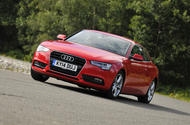
The Audi A5 is a classy coupé, hatchback and cabriolet, but should you take the second-hand plunge?
For some years, the original Audi A5 Coupé of 2007 to 2016 has been sliding down the social scale, such that it is now appreciated only by those who wrap the paint, remove the chrome and fit black alloys.An exaggeration, but it’s a shame just how many of these large, handsome cars have fallen into bad company. Fortunately, sufficient numbers of unmolested examples remain to make shopping for one a far from fruitless endeavour.It will be well worth the effort. In our original review, we praised the A5 – Audi’s first proper 2+2 since the Coupé (B4) bowed out in 1996 – for its desirability inside and out and Audi for overcoming the dynamic frustrations that had always kept the BMW 3 Series out of reach.We also cast our eyes over the soft-top A5 Cabriolet and the five-door A5 Sportback, but it was the two-door that impressed us most.The A5 shares its platform with the A4 saloon and estate. It was launched with a choice of engines that included 187bhp 2.7-litre and 237bhp 3.0-litre turbo diesel V6s (TDI), a 261bhp 3.2-litre turbo petrol V6 (TSI) and a 349bhp 4.2-litre atmo petrol V8 (FSI) in the flagship S5.In late 2007, a 168bhp 1.8-litre TFSI was added; then in 2008 the 208bhp 2.0 TFSI arrived, followed shortly after by a detuned 178bhp version that replaced the 1.8 TFSI.Although A5s were mostly front-driven, there were also Quattro four-wheel-drive versions of the 2.0 TDI, 2.0 TFSI and 3.0 TDI. A 168bhp 2.0 TDI arrived early in 2009, and in the same year all of the engines gained a stop-start system.In 2010, a new range-topper came in the beefy shape of the RS5, which had a 444bhp version of the 4.2-litre V8 and a host of extras, including a new centre differential, torque vectoring and dynamic dampers.All the petrol and diesel engines were uprated come the 2011 facelift, which also brought a sharper look, thanks to new front and rear lights, new LED daytime-running lights, restyled bumpers and a new grille. Meanwhile, the S5 switched to a supercharged 3.0-litre petrol V6.An even more frugal variant of the 2.0 TDI, the Ultra, came in 2014. Our favourite petrols are the 1.8, whose performance is surprisingly strong, and that blown 3.0-litre V6.Among the diesels, we like the 175bhp 2.0 for its usable spread of power and the 3.0 for its effortless performance and great refinement.Given their once favourable tax ratings, diesels heavily outnumber petrols on the used market. Their economy and cruising comfort are attractive, but only the final cohort (from 2016) are Euro 6 – and therefore ULEZ-compliant.The front of the A5’s cabin is roomy, but the driving position is spoiled by a clutch pedal set too far to the right. The infotainment screen may look a bit dated now, but it’s easily controlled by a dial and buttons on the centre console.The A5 looks and feels classy as standard. Yes, even in basic SE trim, with its 17in alloys and leather seats, although it’s more special still in S Line trim (18in alloys, sports suspension, nappa leather and a bodykit) or as a Black Edition (19in alloys and a Bang & Olufsen stereo). Naturally, the S and RS versions are on other levels entirely. Just don’t wrap yours – whether in vinyl or around a tree.Audi A5 2007-2016 common problemsEngine: Early versions of the 1.8 TFSI and 2.0 TFSI suffered high oil consumption, related to the piston rings. Audi allows for one litre per 1242 miles, but 600 miles isn’t unknown.There’s no dipstick, so you’re reliant on the MMI system working. Most of the diesels have a timing belt rated for around 120,000 miles or five years but are cursed with weak plastic tensioners (petrols have a chain). Let the engine warm up and listen for it rattling. Gearbox: The A5 has a light clutch, so a stiff pedal spells trouble. The gearbox is also light, but it’s easy to mess up changes, so check for unusual noises. Problems with the Multitronic CVT range from total failure to shuddering and jerking, as well as overheating. Suspension: The stiffer springing of Sport and S Line models make the ride firmer, unpleasantly so for some people, and larger wheels exacerbate the issue.Brakes: Brake fluid changes every two years are essential.Interior: Be sure you are comfortable with the offset clutch pedal position. Squeaks and rattles from the dashboard and parcel shelf are common.Body and wheels: The edges of the long doors are easily marked and the larger alloys are easily kerbed.
Source: Autocar